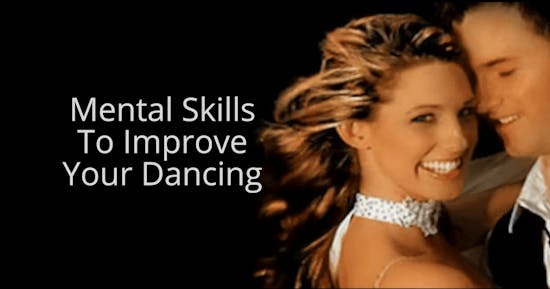Mental training skills to improve practicing and performance for dancing
Mental-Training Skills: Improve Practicing And Performance
The music starts. Donny & Dinah walk onto the floor for their wedding waltz. All eyes are watching. Suddenly, he can’t remember the choreography. Disaster. But, they practiced religiously for months. What went wrong? Donny and Dinah experienced a lapse of concentration. Mental-training skills (a.k.a. sport psychology) would have helped them to refocus after the distraction.
What is mental training?
Mental training teaches how to focus on the task at hand. The skills used in mental training can be applied to learning better, making practice sessions more effective or preparing for a performance. Mental-training skills can be used in any situation where one must perform under pressure. For example, consider a diver about to take her final dive, a figure skater about to start his long program; or perhaps a surgeon in the operating room. Mental training is often the difference between performing well and performing “as well as possible”.
What are the mental-training skills?
Mental-training skills fall into two categories: skills of ’emotional control’ and ‘attention control’ (based on the National Coaching Certification Program, or NCCP, Levels 2 and 3 guidelines on mental training). Emotional control means that the individual has achieved the right combination of mental activity and physical arousal consistent with his or her ideal performance state. In pressure situations, our blood pressure, heart rate, breathing rate, blood flow to the muscles and metabolic rate all increase. This does not enhance learning, practicing or performing. Emotional control balances relaxation with arousal to permit better concentration.
Emotional control uses ‘controlled breathing’ to relax muscles, and ‘positive self-talk’ to build confidence and correct errors. More specifically, four methods are used to evoke the relaxation response: ‘mind-to-body’ techniques, ‘body-to-mind’ techniques, combining physical sensing and mental imagery, and combining controlled breathing and stretching. The competition dancer must work with their coach to determine which methods work best. To be effective, the coach must teach the dancer to relax on cue.
Once emotional control is achieved, attention control helps the dancer focus on the task at hand. Attention control involves concentration, visualization, and refocusing. Concentration is the state of being relaxed and alert to the changing environment. Dancers would liken this to a crowded dance floor. If someone gets in the way, you must react while staying focused on the performance.
Visualization involves rehearsing a positive, mental image of the performance. It can also be used to anticipate problems that may impede performance. Finally, the dancer must be able to regain composure when distracted. This can be done by simulating adverse situations in practices.
Ultimately, mental-training skills must help the individual achieve his or her ideal state of relaxation and activation, which results in a peak performance. In sport, this is called the ” Ideal Performance State”, or the “zone”. When do I need a coach for mental training?
Whether you dance recreationally or competitively, regular use of mental-training skills will improve learning and practicing. If you are in competition training, then you might consider working with a coach to develop mental-training skills in conjunction with dancing skills. The next step is to integrate these skills into a seasonal or yearlong practice schedule which would improve practicing and prepare you physically and mentally for competition.
This article was provided by Tim Mah
Are you ready to start dancing? check out STEP N DANCE for Salsa & Bachata Dance Classes
post by Tony Duarte | Dance Tips & Articles











